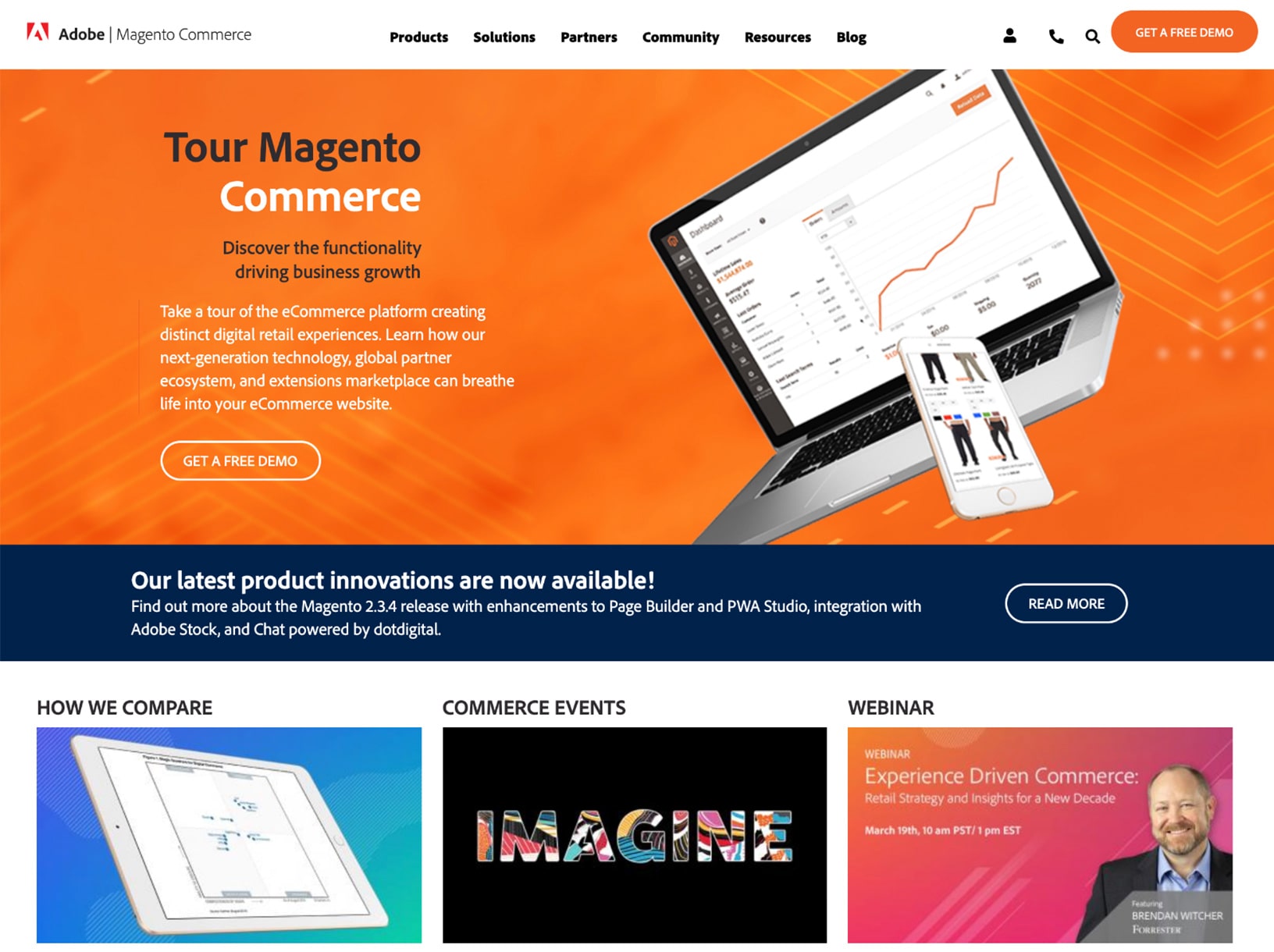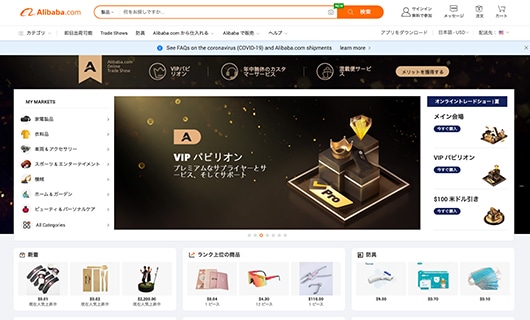ABOUT Magento
What is Magento?
About Magento / Adobe Commerce
Magento is an open source software developed and provided by Magento Inc. of the United States since 2007 as a dedicated EC platform for cross-border EC, and acquired by Adobe Inc. in 2018. In addition to supporting more than 60 languages, which is the international standard, it is an EC package that specializes in "multi-lingual EC construction" and supports more than 50 currencies, making it very flexible and easy to operate.
After becoming a subsidiary of Adobe, Magento Ver.2 was released and became the de facto standard for mail-order websites, with even easier to use and more functions. It is the most popular e-commerce platform in the world, with total product transactions exceeding $155 billion annually. From April 2021, Magento Commerce, the paid version of Magento, is renamed to Adobe Commerce, while the Open Source version remains unchanged and continue to be called Magento Open Source. (Last update: August 19, 2021)

Magento's Share
Magento is the third largest CMS for e-commerce after WooCommerce and Shopify, and is a particularly popular platform for well-known and high-traffic websites such as HP, Nestle, Hanes, Lenovo, Rosetta Stone, Le Creuset, Paul Smith, Muji, JTB, Olympus, Canon, KORG, Monotaro and etc.

Source: eCommerce Thesis
Features of Magento
-
Sales & Customer Management/p>
Unlike other CMS platforms such as WordPress, Magento is designed as a dedicated e-commerce platform made for selling worldwide. You can start a simple e-commerce store with just the standard features. It is designed to be as easy to use as possible for buyers and operators, with a dashboard (admin panel), inventory management, shipping and stock management, product bundling, cross-sell and up-sell functions, newsletters, and more. It is strong not only in B2C but also in B2B.
-
Extensions
Many e-commerce carts are lacking of the functionalities with just the standard features alone, and require the installation of third-party applications or plug-ins. However, the Magento platform can be integrated with ready-made plugins and apps (extensions), or use APIs to work with a variety of paid and free systems and apps, such as inventory linking with e-commerce malls, sales analytics, shipping and tracking, payment gateways, and more.
-
Customization
Each industry has different needs, and what works in the fashion industry, for example, may not work in the furniture industry, even when using a CMS platform.
Magento has the flexibility to be customized to fit your specific industry needs. It is mainly built specifically for e-commerce, but as it is a highly modular open source platform, it can be customized flexibly. In addition to the open source version, an enterprise version is also available, and it is possible to use the dedicated AWS server that Adobe has optimized for Adobe Commerce, and you just need to pay a license fee to Adobe to operate it.
-
SEO Friendly
Since it is always tuned for SEO optimization, its performance in search engine hits such as Google is very good. In addition to hosting all the content information, it is always tuned to appear in the search engine space related to shopping. You can also use SEO enhancement extensions to further customize and adjust the functionality.
Various settings can be configured, including product and category metadata and descriptions, sitemaps for Google and other search engines, and URL control. All this information is embedded in the source code, making the customer experience seamless and simple.
-
Freedom to choose your hosting service
When operating "Magento Open Source", most of the time the server used is basically a cloud server. j-Grab provides our own tuned cloud servers at a reasonable price, but you can also use hosting services provided by Amazon AWS, Adobe, and others.
Various settings can be configured, including product and category metadata and descriptions, sitemaps for Google and other search engines, and URL control. All this information is embedded in the source code, making the customer experience seamless and simple.
-
Load time
International customers don't wait for pages to load any longer than Japanese customers do. If you make them wait even a little bit, they will quickly move on to other e-commerce sites. And the solution to this problem is not simple. You need to pursue efficiency comprehensively, including the compatibility of Magento itself and extensions as well as the hosting service.
As an example, j-Grab caches cross-border EC data in Magento Open Source and CDN, and builds infrastructure that enabling data to be retrieved and displayed immediately from the country being viewed. We continue to improve with all our know-how and mastery to succeed in the field of e-commerce.
-
Open Source
There are three versions of Magento: the free version, Magento Open Source; the paid version, Adobe Commerce (On-Premises); and Adobe Commerce (Cloud), which runs on Adobe's hosting servers. At present, the free version of Magento Open Source (formerly Magento Community Edition) is used in many cases.
Basically, the "Magento Open Source" version is an e-commerce platform that you can download for free, install on your server, and then use Marketplace to install extensions and do a lot of customization. Because it is open source, the platform is constantly being updated, making it safer and more reliable to protect users from hackers.
There is no definition of a finished product in Magento. Problems may occur depending on the version of Magento you are using and the compatibility of the extensions you have installed, but when you use Magento Open Source, you will be able to interact and utilize the community around the world to find the solutions you need and help each other.
-
Mobile Friendly
In terms of overseas e-commerce usage by device, many people are using mobile phones to access e-commerce sites due to the decline in desktop (PC) usage. In some countries, more than 80% of the population uses smartphones or tablets, and in other countries, the use of smartphones is growing even faster than in Japan, how to build a mobile-friendly website has never been more important.
Magento's UX comes with mobile-friendly technologies such as responsive design as a standard feature. It is possible to provide the best customer experience in the smartphone field.
-
Multiple websites with a common backend
Normally, an e-commerce site would be complicated, as you have to create an e-commerce site for each country and manage the servers separately, but this is not the case with the Magento e-commerce platform. It is possible to build and provide an independent EC site without the need for separate back-end systems, such as for each country.
-
Analysis and tracking
The Magento e-Commerce platform is designed to be analyzed using Google Analytics, but in some cases we can also deploy our own analytics and tracking tools called Adobe Commerce Business Intelligence. The tool is customizable and designed to be used by both business users and engineers.
-
Other Features
・Product Management・Customer Management ・Order Management
・Global support with support for multiple languages, multiple currencies, and tax management
・Linkage with huge e-commerce malls such as Amazon and eBay is possible.
・Promotion management functions such as coupons and points
・Multiple stores can be built from a single management screen.
Comparison between Magento Open Source and
Adobe Commerce
-
What is Magento Open Source?
Magento Open Source is published as open source.
It is available to everyone, and can be freely customized as needed. If there is a lack of functionality in the standard version, it can be expanded by installing paid or free extensions (plug-ins), which are constantly evolving in cooperation with Magento developers around the world. -
What is Adobe Commerce?
Compared to the open source version, Adobe Commerce (paid version) has a relatively high implementation cost and is designed for businesses that believe that open source is not sufficient. It is used by large online stores that require advanced features and customizable options.
Adobe Commerce is supported by Adobe's dedicated team for infrastructure and failures, with additional phone and email support. The price includes security updates, support for adding special functions and enhancements, and the cost is estimated individually, but it seems to range from 6 million yen and up.
-
Cost
The most commonly compared difference between the two is the implementation cost. Magento Open Source allows you to get the package for free, while Adobe Commerce requires a fee and at least an annual license fee in addition to the build cost. In addition, since it is rare case to operate the EC sites using only the package itself, it is necessary to add the extensions to expand the functionalities, and corresponding costs will be required.
-
Security
Magento Open Source is a very secure e-commerce platform, but it is not permanently secure. Version upgrades and security patches are frequently distributed to keep up with new wonders, and must be implemented from time to time. You must operate at your own risk, so if you are unable to take these actions on your own, you will need to contact a specialist. Also, if you plan to operate your own infrastructure, so you will need to focus on the security of your hosting server and network.
-
Performance
Even though Magento Open Source is very feature-rich and fast, but it provides strong performance for building stores that require more modules and more listings. For this reason, it is recommendeded that you use the paid version of Adobe Commerce when building a large-scale e-commerce site.
-
Functionalities
Magento works very well and fast, especially because Magento Open Source and Adobe Commerce use the same core technology, but Adobe Commerce has more advanced features inside. Examples include targeted product management, ad pricing adjustment, returns management and approval processes, price adjustment and promotion management, advanced catalog management to content management systems, and call centers with rollback support in case of major problems.
Magento admin panel
Magento admin panel is available in Japanese. While it is possible to arrange and adjust the system at any time from the admin panel, there are many tabs and setting items, and it is sometimes said that it takes time to get used to the operation. Therefore, j-Grab provides a "delivery workshop" to be held before the start of business, and an easy-to-understand "usage guide" with many screen captures.
-
Dashboard
![]()
-
Product Information Entry
![]()
-
Select a category
![]()
-
SEO and Meta Information
![]()
-
Inventory control and backorders
![]()
-
Shipping management
![]()
Points to note about Magento
- Since Magento Open Source is an EC package made in the U.S., it is necessary to utilize the English Magento community for construction, implementation, and operation. Also, since there is no manual in Japanese, you need to have the English ability to comprehensively read, understand, and respond to information about Magento.
- The initial construction and development is complicated, making it quite a hurdle for beginners.
- It takes a lot of time and effort to build a site, and if it is done by someone who is not familiar with it, it will take a long time before it is ready for service.
- In some cases, customization makes it impossible to upgrade or install security patches.
- Magento Open Source does not have customer support, so you will need to solve problems on your own as well, using the community and other resources.
What can j-Grab do for you?
Magento is the world's most powerful e-commerce platform for building cross-border e-commerce sites, with support for multiple languages and multiple currencies.From building a small cross-border EC site with a small number of products to linking with highly difficult extensions and external systems, in order to realize everything you want to do as much as possible, j-Grab's Magento building specialists not only build your Magento site, but also providing companionship support for you with a comprehensive management approach that includes sales methods, customer attraction, and infrastructure.
We offer plans that includes j-Grab's unique EC site construction and companionship support, which is possible only because we have built more than a few hundred Magento sites and are well versed in Magento. In addition to various setup support and support in case of trouble, we also offer special exclusive consulting contracts for businesses that have already operated Magento and for foreign companies using Magento in Japan.
For those who want to build or open a cross-border EC site with Magento Open Source or Adobe Commerce, for those who have already opened an EC site but sales are not increasing, for those who are losing in the price competition and your EC sales are unprofitable, or those who want to who would like to link the oversea EC Mall or local EC Mall like eBay, Amazon, Shopee, etc. with your own cross-border EC site and succeed in the main website and sub-site strategy, j-Grab's cross-border EC consultants provide consultations, individual consultations, about increasing sales from store opening and store construction. Please feel free to contact us from the Contact Us page.
Edit:j-Grab Cross-border EC Lab














